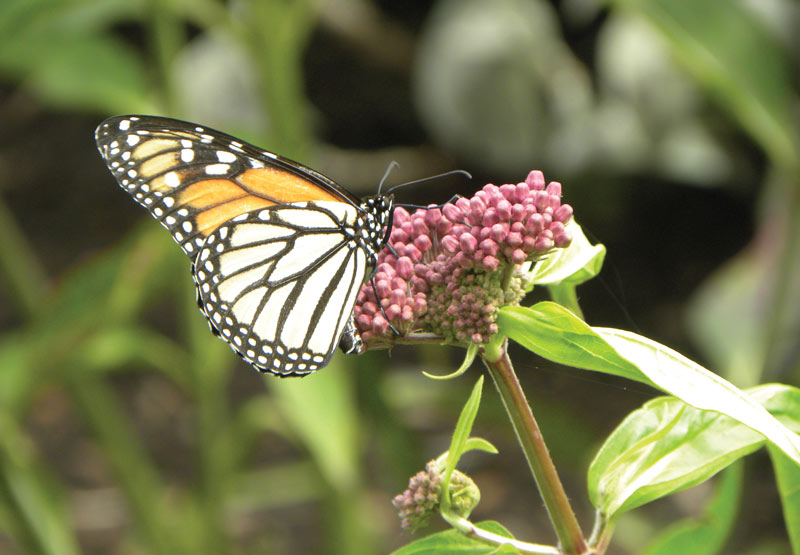
Rockland Country Club in Sparkill, N.Y., keeps a close eye on its monarch populations and its milkweed plants. Photo by Matt Ceplo
Kelly Kuchelmeister knows the Monarchs in the Rough program has increased the number of the eponymous iconic butterflies found at Sinnissippi Park Golf Course in Rockford, Ill. She has no idea by how many.
“In the past, we didn’t really notice,” says Kuchelmeister, superintendent at the historic nine-hole public course and an eight-year GCSAA member. “Maybe we’d be, ‘Oh, there’s a butterfly.’ The last couple of summers, though, you’re actually noticing them when you’re mowing up and down the rough. It seemed like quite a few — tons of monarchs.”
Of course, that’s the point of Monarchs in the Rough, a joint venture of Audubon International and the Environmental Defense Fund that encourages golf courses to establish habitat for the threatened — according to a December 2020 announcement from the U.S. Fish and Wildlife Service, that word is appropriate — monarch butterfly.
Monarchs in the Rough planted the seed — metaphorically — that golf courses could help stem the loss of monarchs and earn recognition in their communities as environmental leaders. To that end, the program, through a grant from the National Fish and Wildlife Foundation, provided enough regionally appropriate milkweed and wildflower seeds to golf courses in states west of the Mississippi River and around the Great Lakes (like Sinnissippi) for each to establish an acre of quality monarch habitat.
Sinnissippi Park was on the leading edge. Though Monarchs in the Rough got underway in earnest in 2018, a few pilot plots went in the previous year.
Now, those early (Monarchs in the) Roughs are, potentially, maturing. The next logical step is to see whether those plants have taken root — and whether they’ve done anything to help the monarch, whose population has plummeted as much as 95% over the past few decades because of development, pesticide use and climate change.
The Integrated Monarch Monitoring Program (IMMP) is a national program by the Monarch Joint Venture and Audubon International that, as the name suggests, monitors prairies restored through Monarchs in the Rough and contributes to a vast nationwide effort to compile data on monarchs and how they interact with the environment. More than 700 properties have committed more than 1,020 acres of the milkweed plants monarchs need to survive through Monarchs in the Rough. The IMMP is part two.
“Somebody smarter than me said, ‘You can’t manage what you don’t measure,’” says Matt Ceplo, CGCS, superintendent at Rockland Country Club in Sparkill, N.Y., a 35-year GCSAA member and treasurer of Audubon International. “We need to start measuring things.”
By “we,” Ceplo means golf course superintendents in general. After all, Rockland already monitors monarchs through Monarch Watch, a more in-depth program that also includes capturing, tagging and releasing the orange-and-black beauties.
The Integrated Monarch Monitoring Program is a bit less demanding. Representatives from participating courses are encouraged to sign up, then once during peak bloom — say, July in the Midwest — record information on habitat size, number of milkweed stems by species, flowering plant species, and, optionally, presence of monarch eggs, caterpillars and adults. The program provides all sorts of training resources, and the suggested time requirement is between 30 minutes and an hour and a half.
Courses aren’t limited to annual counts. All information will go into a centralized database — a nationwide community science project.
“There are a couple of reasons for it,” says Jennifer Thieme, regional monitoring coordinator for Monarch Joint Venture. “One is just to see if the investment is working out. There are a lot of resources that go into these projects, and we need to learn what’s growing at what time of year. We can also correct actions. If an invasive species is encroaching, we might want to reconsider what’s being planted.”
Though the golf course piece is just a part of the IMMP, Thieme is particularly fond of the role golf courses and their managers can play in monarch conservation.
“It’s a good relationship for us to have, because they have that type of staff experienced in making plants grow,” she says. “This (program) hits on so many key pieces in monarch conservation. Sometimes it can be difficult to get these resources available to monarchs in all kinds of landscapes, including developed landscapes where, frequently, golf courses are. Golf courses really can be islands of habitat in a sea of development.”
Much more on monarchs from GCM
Check out the following resources for further information and ideas, and to hear from superintendents who’ve successfully established monarch butterfly habitat in their golfscapes.
Making a way for monarchs
This primer from 2016 offers how-to from Scott Hoffman Black, executive director of the Xerces Society, on establishing habitat for monarch butterflies, and spotlights the monarch-welcoming work of GCSAA Class A superintendent Isaac Breuer at Gustin Golf Course in Columbia, Mo., where monarch conservation has long been a focus.
Pollinators in the turfgrass ecosystem: Best management practices
Protecting and preserving pollinators through pesticide stewardship and best management practices is imperative for the turfgrass industry. Here are guidelines for doing just that.
Planting milkweed for monarch butterflies at Meadow Club
David Sexton, CGCS, shares tips gleaned from experimenting with various milkweed planting methods at the California golf course.
Advocating for western monarchs at Stewart Meadows Golf Course
The nine-hole facility in Medford, Ore., has five certified monarch waystations, which are a rarity in the Pacific Northwest.
Andrew Hartsock is GCM’s managing editor.